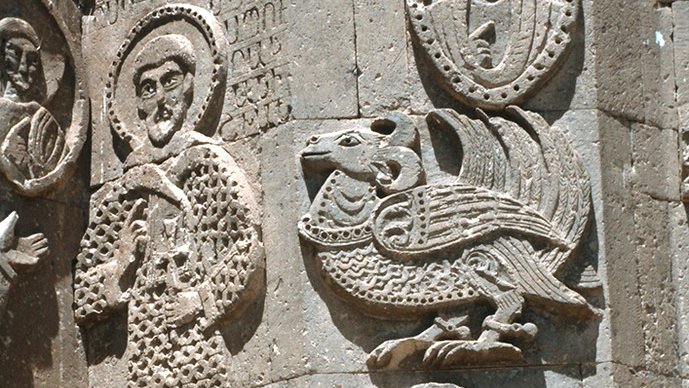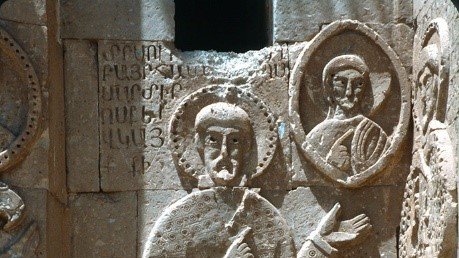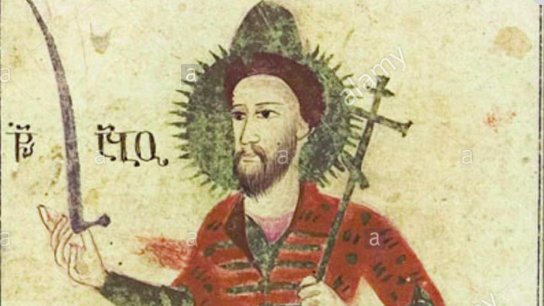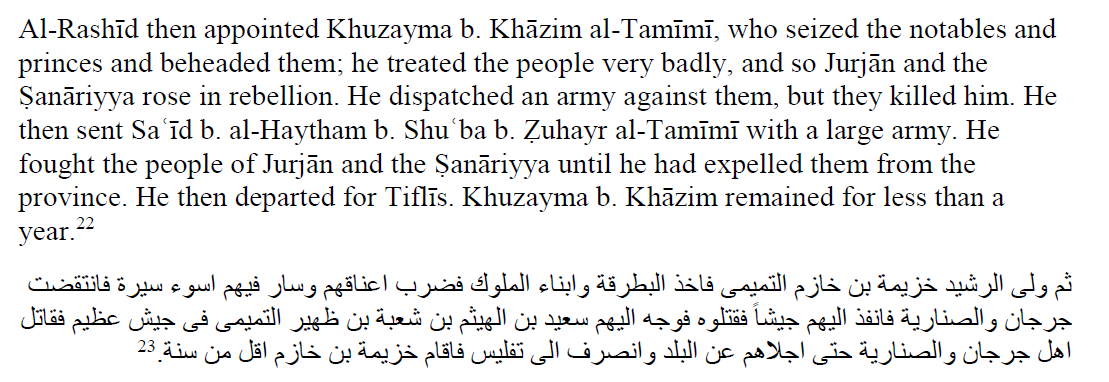A thread on princes executed during the reign of the caliph Hādī (169/785 -170/786). Let me introduce you to Hamazasp Arcruni, #Armenian prince of Vaspurakan. his brother Sahak is right next to him, but I wanted this pic bc I like the simurgh. #priorities. 1/20
Here’s Sahak, Hamazasp’s brother. The inscription says they’re “martyrs and witnesses” (մարտիրոսք եւ վկայք). These images come from the church on Ałt‘amar, built in 914CE․ 2/20
[tangent: worth the trip, this church is on the island of Ałt‘amar in the middle of Lake Van, now in eastern #Turkey] 3/20
[Also, check out this book abt the church (disclaimer: it includes my chapter on Vaspurakan and the Arcrunik‘ in Arabic sources—البسفرجان and بنو الديراني)]: https://brill.com/view/title/54635]">https://brill.com/view/titl... 4/20
Anyway, Łewond (8th cent) says that Hamazasp, Sahak, and Mehružan Arcruni went to Dabīl/Duin, where the governor Khuzayma b. Khāzim tempted them to convert to Islam. Mehružan converted. He is not on the church at Ałt‘amar, obvious reasons. 5/20
Łewond dates martyrdom as Epiphany of 233AE = 6 January 785CE… which is before Hādī became caliph. But maybe a scribe read գ for դ and really meant 234AE, so 786CE. Asołik (11th cent) works from Łewond and he says they died in 234AE. 6/20
So hey: in case you’re worried abt making mistakes when you try something new, remember that the very first time anyone used the Armenian era in a text… it was incorrect! [another tangent: Armenian era appears one earlier instance, but in inscription at T‘alin] 7/20
Łewond says the brothers died bc Khuzayma “was truly hellish and warlike” (արդարև… խազմարար և դժոխաձև). he derives Khuzayma’s name from խազմ (xazm), which means “war.” BUT the brothers’ Vita says that Khuzayma was told that the brothers were rebels against caliph. 8/20
Why should we care? Bc now we know what Yaʿqūbī was reporting here [tho he puts Khuzayma in reign of his bff Rashīd—that’s a long story for another day]: 9/20
Hamazasp and Sahak die as martyrs, to be commemorated on Ałt‘amar. Their brother who converted to Islam is killed off, tho doesn’t merit an ending in Łewond. Łewond then tacks on an extra note that Hādī also had a young Georgian prince executed, removing his hands and feet. 10/20
CHOICE ONE: Habo, the patron saint of Tbilisi. He was executed on… Epiphany of 786—the exact same day as Hamazasp and Sahak (coincidence??). Habo was an Arab perfumer who converted to Christianity and was executed in Tbilisi for apostasy. 12/20
Problem with this ID, though? It’s hard to believe that Łewond heard “Arab perfumer” and wrote “Georgian prince.” Not really a great fit, even if timing and fame are spot-on. 13/20
CHOICE TWO: Arč‘il, the prince of Kaxet‘i, was killed that same year by a governor named Asim [maybe that renders Khāzim??]. There’s a whole book about him in K‘art‘lis C‘xovreba. 14/20
I like this ID, in part bc Yaʿqūbī again chimes in. he puts Khuzayma against the Ṣanāriyya (Canark‘ in Armenian, or Σαναραῖοι). The Ṣanāriyya lived in Kaxet‘i. Where Arč‘il ruled. 15/20
Two problems with this: 1. Georgian source says that the gov was called Asim, but his name was really Čičnaum son of Mohamedi ((ჭიჭნაუმ ძე მოჰამედისა; Ճիճնաում որդի Մահադեայ). I can& #39;t explain that name…? 16/20
2. Łewond says the Georgian prince was young; Arč‘il was not. He had 6 kids when he died, all of whom of marriageable age. 17/20
Asim asked Arč‘il for treasures hidden by Heraclius. Arč‘il said: “Know well that I was young in age when Heraclius crossed this land” (უწყოდე მტკიცედ, რამეთუ მცირე ვიყავ ასაკითა, ოდეს-იგი განვლო ქუეყანა ესე ერაკლე მეფემან; Յորժամ էանց ընդ երկիրս մեր Հերակլ՝ տղայ էի ես). 18/20
Say Arč‘il was 5 when Heraclius went through around the time of recovery of True Cross in 628. That would make him a spry 160 yrs old in reign of Hādī. The author jumped a couple of years bc the names in Arč‘il’s immediate family = same as 7th cent generation. 19/20
End of thread: Idk who the Georgian prince was for sure. But Łewond’s history, written just a few years after the reign of Hādī, is interesting up against martyrologies in Armenian & Georgian. Arabic sources are important here, too. Łewond’s martyrs = Yaʿqūbī’s rebels. 20/20

 Read on Twitter
Read on Twitter

![[tangent: worth the trip, this church is on the island of Ałt‘amar in the middle of Lake Van, now in eastern #Turkey] 3/20 [tangent: worth the trip, this church is on the island of Ałt‘amar in the middle of Lake Van, now in eastern #Turkey] 3/20](https://pbs.twimg.com/media/EYpwBEvXYAMyjzK.jpg)
![[Also, check out this book abt the church (disclaimer: it includes my chapter on Vaspurakan and the Arcrunik‘ in Arabic sources—البسفرجان and بنو الديراني)]: https://brill.com/view/titl... 4/20 [Also, check out this book abt the church (disclaimer: it includes my chapter on Vaspurakan and the Arcrunik‘ in Arabic sources—البسفرجان and بنو الديراني)]: https://brill.com/view/titl... 4/20](https://pbs.twimg.com/media/EYpwMVmWoAETWP7.jpg)

![So hey: in case you’re worried abt making mistakes when you try something new, remember that the very first time anyone used the Armenian era in a text… it was incorrect! [another tangent: Armenian era appears one earlier instance, but in inscription at T‘alin] 7/20 So hey: in case you’re worried abt making mistakes when you try something new, remember that the very first time anyone used the Armenian era in a text… it was incorrect! [another tangent: Armenian era appears one earlier instance, but in inscription at T‘alin] 7/20](https://pbs.twimg.com/media/EYpwlAPXgAIJinJ.jpg)

![Why should we care? Bc now we know what Yaʿqūbī was reporting here [tho he puts Khuzayma in reign of his bff Rashīd—that’s a long story for another day]: 9/20 Why should we care? Bc now we know what Yaʿqūbī was reporting here [tho he puts Khuzayma in reign of his bff Rashīd—that’s a long story for another day]: 9/20](https://pbs.twimg.com/media/EYpx9i3WkAITynf.png)


![CHOICE TWO: Arč‘il, the prince of Kaxet‘i, was killed that same year by a governor named Asim [maybe that renders Khāzim??]. There’s a whole book about him in K‘art‘lis C‘xovreba. 14/20 CHOICE TWO: Arč‘il, the prince of Kaxet‘i, was killed that same year by a governor named Asim [maybe that renders Khāzim??]. There’s a whole book about him in K‘art‘lis C‘xovreba. 14/20](https://pbs.twimg.com/media/EYp06mNXkAEx5of.jpg)




